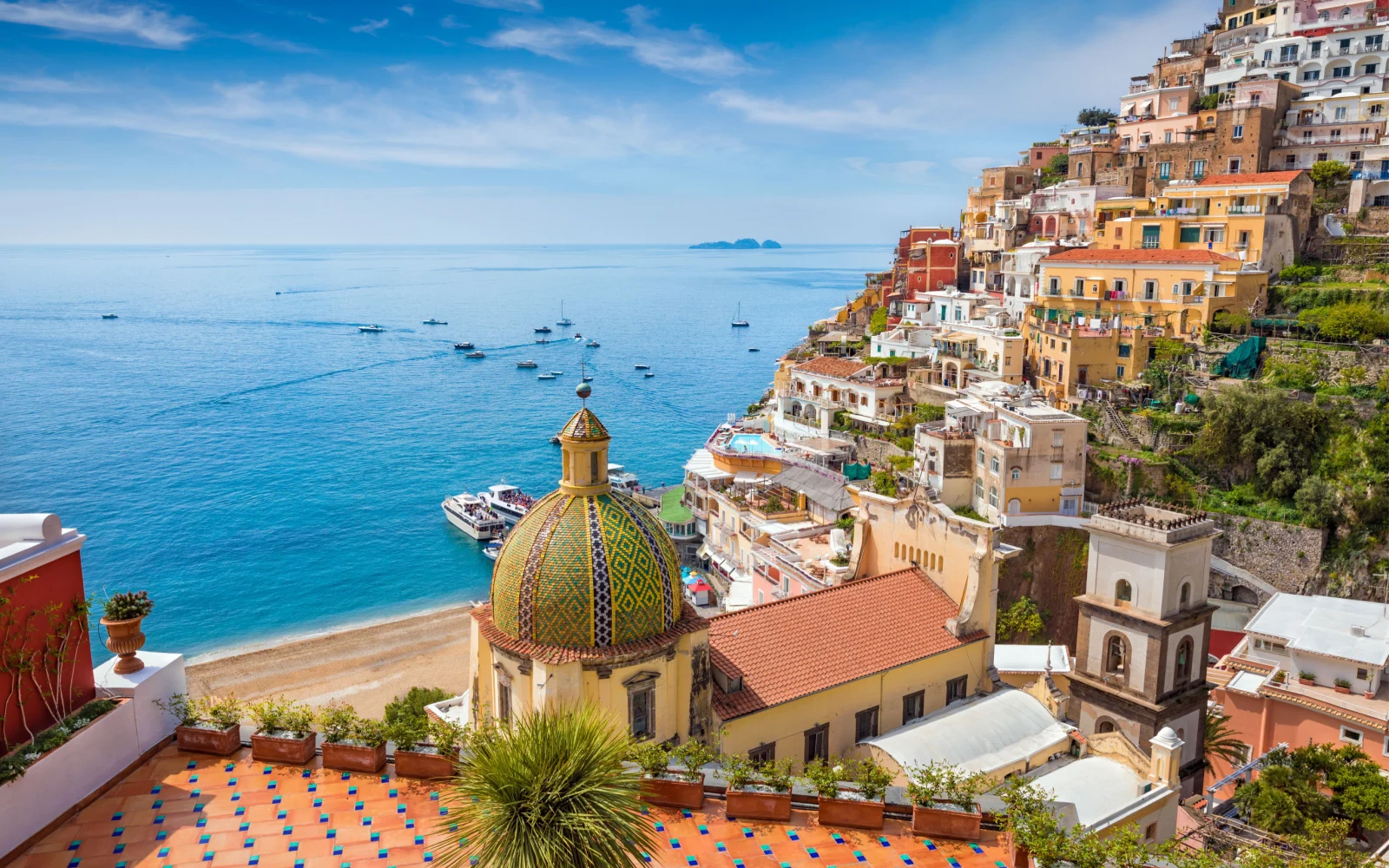What's the best time to visit the Amalfi Coast?
The best time to visit the Amalfi Coast is in the spring (April to June), when you’ll experience great weather and fewer tourists. For budget travelers, winter (November to February) brings lower prices, but expect cold weather. February and November offer a peaceful escape from the crowds.
The Mediterranean charm of southern Italy’s Amalfi Coast is undeniable, with its sandy and pebbled beaches set in front of dramatic cliffs, 13 picturesque seaside towns, terraced olive groves and vineyards, and beautiful medieval architecture.
Learning the best time to visit the Amalfi Coast will get your upcoming trip off to a great start.
Famous for its hilly terrain and winding cobblestone streets, Italian cuisine centering around fresh seafood and pasta, tart-sweet limoncello, an Italian lemon liqueur, and regional wines like red Sabato and white Falanghina, it’s no wonder this stretch of coast has been nicknamed the “Divine Coast.”
You’ll optimize your visit by finding out the best, cheapest, least busy, and worst times to head to the Amalfi Coast below. We’ll share everything you need to know, from weather conditions by season to festivities and events taking place when you visit.
From the cliffside village of Positano all the way to the colorful, historic architecture of Vietri sul Mare, here’s a look at the best time to visit the Amalfi Coast!
Overall Best Time to Visit the Amalfi Coast
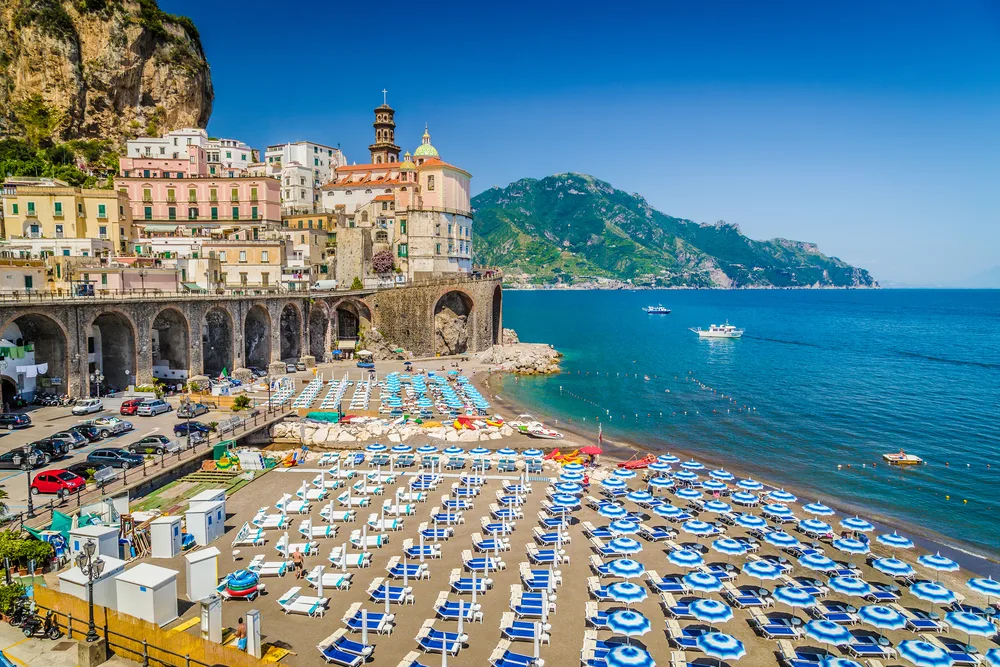
Canadastock/Shutterstock
The best time to visit the Amalfi Coast overall is from April to June, the warm start to the peak season with smaller crowds than July and August.
Once spring is sprung on the coast and summer begins to take hold from April to June, tourists begin to book up the best hotels and guesthouses in popular towns like Amalfi and Positano. If you plan ahead and book early, this is the prime time to schedule your stay.
You can expect great weather between April and June along the coast, with things heating up from 64-66°F (April) to 73-74°F (May), and 80-82°F (June). Rainfall is less common as the late spring/early summer wears on, dropping from 1.8″ in April to just 0.7″ by June.
While this is the start of the high season, you’ll find fewer travelers in the charming seaside villages if you get there before July and August, the height of the peak season. The earlier in this period you visit, the less busy and expensive your trip will be.
Hotel prices vary by the town, so we’ve analyzed Google Hotels nightly rate data for 2-5 star hotels and guesthouses in Positano and Amalfi, the two most popular destinations, to give you an idea of how much you’ll pay from April to June:
- April: $399/night
- May: $923/night
- June: $787/night
Enjoy strolling cobblestone streets and alleys in Positano, exploring terraced vineyards in Ravello, boat cruises from town to town, going to the wide, sandy beaches in Maiori, and enjoying satisfying seafood and pasta meals with a glass of wine all’aperto (in the open air).
Everything’s open as local businesses and tour companies welcome the high season’s start, but note that the water’s still cool in April (around 61°F, warming to 70-77°F by May and June).
Festivals and events are huge this time of year when the coast is humming with life. Here are some events you can plan to check out:
- Holy Week (Mar./Apr.): Towns along the coast honor Holy Week with special ceremonies, solemn candlelight processions, and celebrations like battenti on Holy Thursday, schiodazione Christ reenactment on Good Friday in Positano, and huge Easter feasts marking the end of lent.
- Festival of Sant’Andrea (Jun.): Town-wide festival in Amalfi with fireworks displays, concerts in Piazza Duomo, processions, and Holy Mass honoring the patron saint of fishermen
- Regatta of the Ancient Maritime Republics (Jun.): Annual reenactment of the Amalfi Coasts’ historic rivalries with Venice, Pisa, and Genoa with a rowing race, hosted in Amalfi every 4 years
- Ravello Festival (Jun.-Oct.): Classical music concerts happen weekly from June to October, featuring jazz, opera, and dance performances with special highlights like a sunrise orchestra concert
Visiting in April might be your best bet if you’re okay with the cooler sea temperatures because it offers lowest prices and smallest crowds during the peak season. May and June are warmer and more eventful, but also more expensive and crowded.
Cheapest Time to Visit the Amalfi Coast
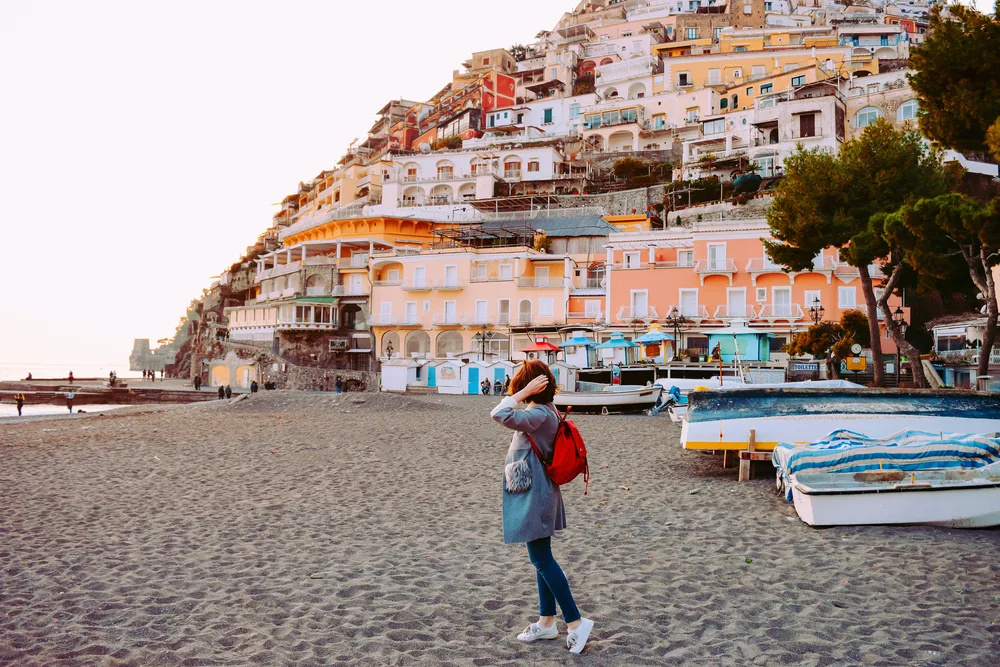
Positano, Amalfi coast, Italy – 02/03/2019: Girl with red backpack staying on a beach and watching Positano from below. Off season at Amalfi coast, One of the most popular destinations and UNESCO site/Znatalias/Shutterstock
The cheapest time to visit the Amalfi Coast is from November to February, when cold weather takes hold of the coast, the towns wind down for the season, and lower demand makes prices drop.
November marks the start of the low season along the Amalfi Coast, leading to much lower prices on hotels and guesthouses in the coastal and hilltop towns. If budget is your top priority, this is the best time to visit.
Check out the lower-than-average hotel prices around the coast from November to February, according to data from Google Hotels:
- November: $207/night
- December: $312/night
- January: $357/night
- February: $346/night
These prices, around $200-$360/night, are much more agreeable than what you’ll pay during the (admittedly warmer and more eventful) peak season. You’ll be able to stay longer and still spend less than you would in spring or summer!
But it’s a challenging time to visit the coast because so many businesses and services shut down for the season once cold weather arrives. The ferries stop operating, many popular hotels and restaurants shutter their doors, and daily tours and activities slow down considerably.
The weather is the culprit for the lower prices, with highs reaching just 53-64°F in the coastal towns. Sea temperatures are too cold for swimming at the beaches at 59-68°F (warmest in November). Rainfall adds another difficulty for enjoying your stay fully during this time of year.
November is rainy (3.8″ on average with 11 rainy days), with each month afterward seeing slightly less rain (3″ in December, 2.6″ in January, and 2.4″ in February). It’s much less fun to explore and wander the coastal villages of the Amalfi Coast this time of year.
But all is not lost if you visit during the cheapest time of year on the Amalfi Coast. There are still a few events taking place that can put you in touch with the region’s unique culture and traditions:
- Festival of Sant’Andrea (Nov.): Twice-annual festival honoring the patron saint of fishermen takes place with a special feast, statue procession of the saint, and Holy Mass
- Christmas celebrations (Dec.): All towns on the coast get decked out in Christmas decor and hold Christmas pageants, nativity scene crèche competitions, special Masses, and holiday markets
- Festa della Zeppola (Dec.): Annual traditional zeppole (donut) food festival in Positano brings people to the beach for samples, meals, and camaraderie as people make and judge pasta, potato, and sweet donuts fried in oil
- New Year’s Eve (Dec. 31): From fireworks over the harbor to all-night events in the town squares and church bells ringing in the new year, tons of events take place on December 31 across the Amalfi Coast
- Carnevale (Feb/Mar.): Celebrations center around Maiori with big, decorated floats carrying costumed performers as celebrating locals walk alongside with music, dancing, singing, and food
While you won’t be able to swim at the beaches, enjoy ferry rides to the other towns, or experience all the great restaurants and hotels that are only open during the peak season, you can visit for a fraction of the price by coming between November and February.
Least Busy Time to Visit the Amalfi Coast
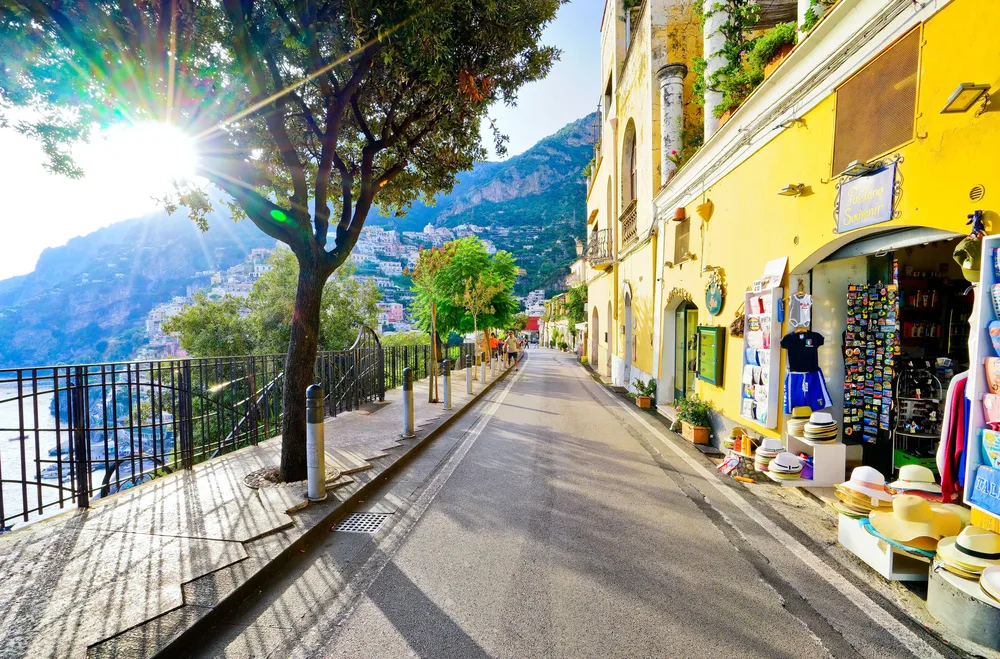
Positano, Italy – September 16, 2016 : View of the main street on a sunny day along Amalfi Coast in Positano, Italy on September 16, 2016/Javen/Shutterstock
February and November are the least busy times to visit the Amalfi Coast, being off-season months with cold weather and a “locals only” time for the coast.
If you’re seeking a less crowded experience on the Amalfi Coast, you can’t beat the months of February and November. November is just ahead of the small increase in travelers around Christmastime, and February is a month with few travelers after the New Year.
Both November and February mean chilly conditions on the coast, but November is considerably warmer with more rainfall (about 11 rainy days compared to 8 in February). Expect highs around 61-64°F in November and 54-56°F in February — not quite ideal for beach days, but perfect for strolling through Praiano or visiting a spa in Minori.
The lack of tourists makes it a really relaxing, laid-back time to experience the coast like a local. And as an added benefit, you’ll find the prices on hotels (the ones that don’t close for the season) to be much cheaper than the peak or shoulder seasons.
Here’s what the current Google Hotels data looks like for 2-5 star accommodations in November and February:
- February: $346/night
- November: $207/night
With the feeling that you have the coast to yourself, this is a prime time to do some exploring and walk through the towns when they’re populated mostly by locals.
Take a bus or drive over to nearby Sorrento, where things don’t close down for the winter season and you’ll find shops, restaurants, and more things to do. Or check out events happening on the Amalfi Coast, like the Festival of Sant’Andrea in November or Carnevale in February (sometimes March).
With low prices on hotels and the freedom to wander around nearly-empty squares and streets, November and February can be a nice time to visit — as long as you realize what you’re signing up for in terms of cold weather, rain, and seasonal closures.
Worst Time to Visit the Amalfi Coast
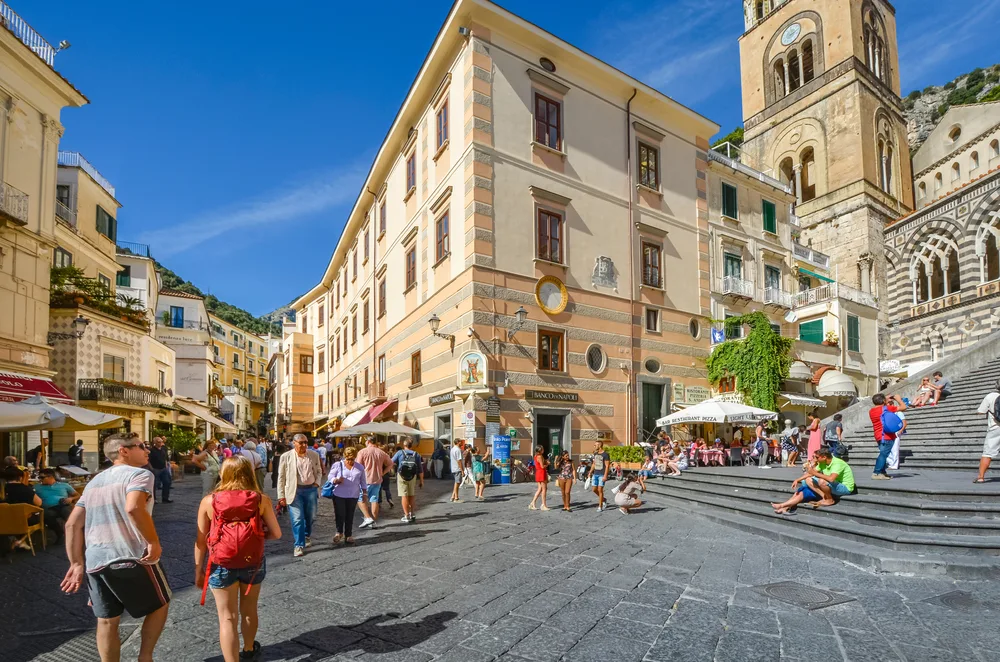
Amalfi, Italy – September 18 2019: The center of the town of Amalfi on the Amalfi Coast of Italy with the stairs leading up to the famous Amalfi Cathedral as tourists shop and dine/Kirk Fisher/Shutterstock
The worst time to visit the Amalfi Coast is July and August (hot, crowded, and expensive) or November through March (rain, winter closures, and cold weather).
With two less-than-ideal periods of the year to visit the Amalfi Coast, you’ll need to consider your travel goals to determine which period is actually the worst for you. If you’re a bargain hunter or hate crowds, July and August will be the worst months.
But if you’re hoping to get the classic Amalfi Coast experience, November through March is going to be the worst time to go because so many hotels, restaurants, and tour companies shut down for the winter when the weather is cold and tourism dwindles.
July and August are expensive, in line with May, June, and September, but they’re much hotter with highs around 86-88°F and much bigger crowds than the early or late summer months bring. It’s the busiest time of year across the coast and that can interfere with the quality of your visit.
But November through March is frustrating in other ways. The weather is too cold for beaches (53-64°F on average), rainy (8-11 rainy days each month), the ferries aren’t running, and you’ll find fewer hotels, restaurants, and shops open to check out while you’re there.
Here’s a look at the average nightly rate for 2-5 star hotels during July-August and November-March periods on the Amalfi Coast, according to Google Hotels data:
- July: $768/night
- August: $684/night
- November: $207/night
- December: $312/night
- January: $357/night
- February: $346/night
- March: $519/night
July stands out as the most expensive and driest month to visit during these periods, while November is the cheapest and rainiest. We’ve looked at the events that happen in November-February, but here are some others from the late summer and March:
- Ravello Festival (Jun.-Oct.): A festival honoring classical music with concerts, orchestras, and dance performances around Ravello in the hilltop town from June to October
- Positano Teatro Festival (Jul.): A theater festival in Positano celebrating all the arts, including music and dance, with concerts, exhibitions, and plays along with special awards ceremonies
- Feast of Madonna Delle Grazie (Jul.): The people of Montepertuso and Positano (along with much of southern Italy) gather to feast in honor of Santa Maria Delle Grazie, complete with a big fireworks and light shows, reenactments, and more
- Feast of the Assumption (Aug.): Positano’s big religious festival means a colorful fireworks display you can watch from the beach and a town-wide procession of a Madonna with Child statue down to the beach
Only you can know which period would be a nightmare for you — July and August if you’re hoping to score a deal or enjoy peace and quiet, or November-March if you’re looking to spend time on the beach, ride the ferries, or enjoy the warm coast at its peak.
Things to Consider
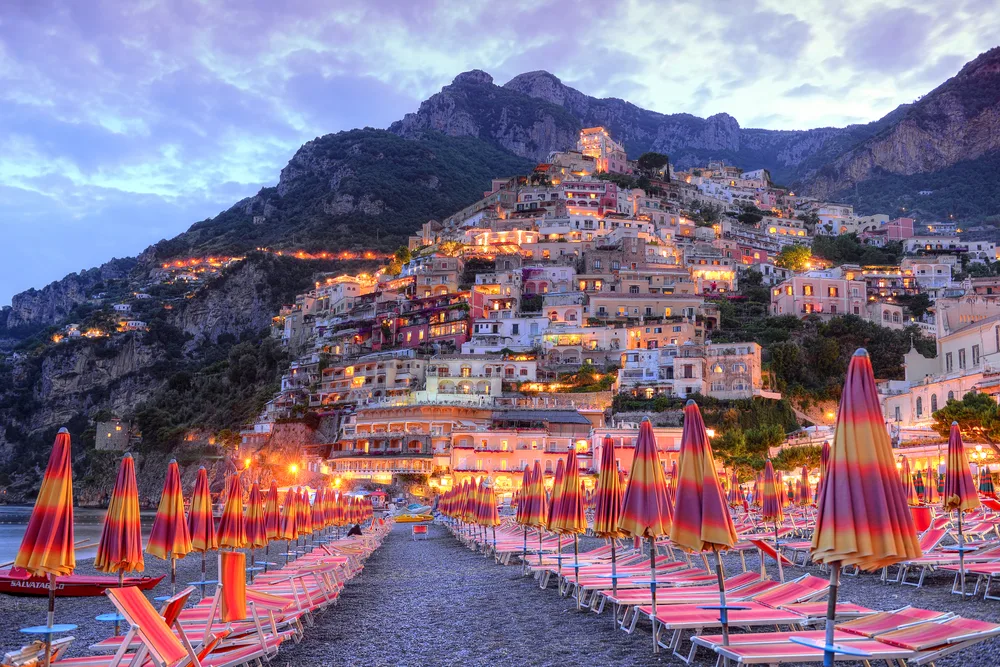
Cristina Trif/Shutterstock
Figuring out the best time to visit the Amalfi Coast is only the first step to planning a great trip to Italy’s beautiful southern shores. Keep the following pointers in mind to maximize your visit!
- It’s very hilly. Whether you’re not about that hill-climbing life, are bringing kids or older adults, or have trouble walking uphill, know that the Amalfi Coast is set on dramatic cliffs and most of the towns are very hilly. Maiori is the flattest town, so consider it if you want to avoid a lot of elevation changes.
- Check out the hidden gems. Towns like Praiano, Vietri sul Mare, and Cetara are less-visited than the stars like Positano and Amalfi. If you’re looking for a more laid-back visit, even in the peak season, heading to these hidden gems will afford you a more relaxed, less-crowded visit.
- Don’t just focus on the coast. Sure, it’s the Amalfi Coast, but a few of the towns here are not actually on the coastline and are set further back, up in the hills. Ravello is a great example, and while it doesn’t sit right on the shore, it’s got some really nice villas with gardens, terraced olive groves and vineyards, shops, and restaurants.
- Take a ferry to other towns. Visiting one town on the Amalfi Coast doesn’t mean that’s your only destination. Ferries run during the high season, from April to October, and can take you to other towns along the coast with scenic views along the way. For example, the Amalfi to Positano ferry takes about 20 minutes and costs €9-10 ($10-11).
Frequently Asked Questions
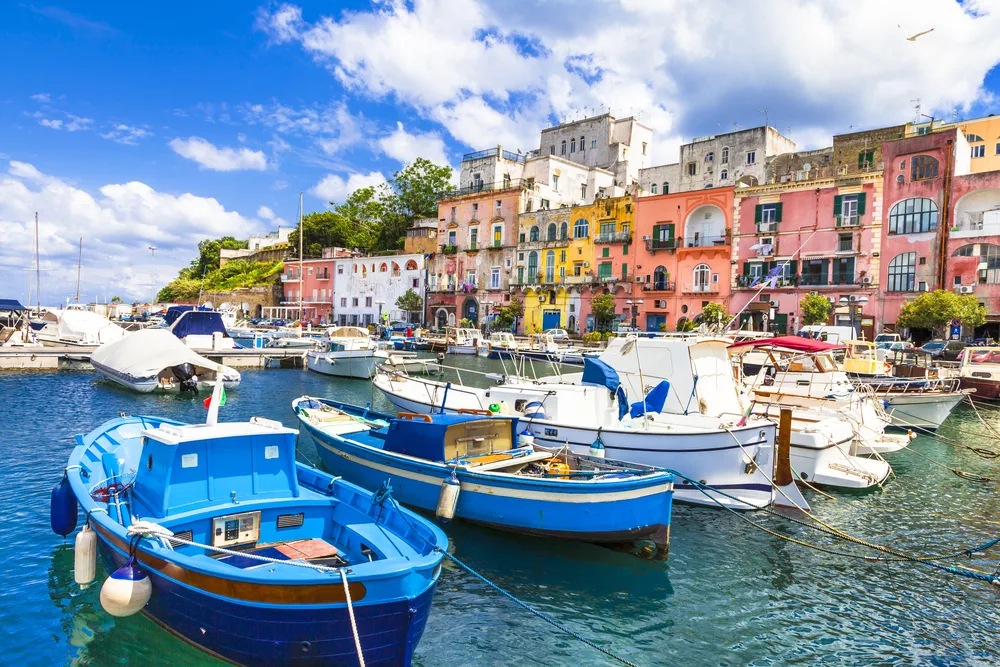
Leoks/Shutterstock
Make the most of your Amalfi Coast adventure by checking out some of the frequent questions other travelers have about this destination.
What is the best month to go to the Amalfi Coast?
The ideal time to visit the Amalfi Coast is during the late spring (May to June) or early fall (September to October). These months offer comfortable weather, fewer crowds, and stunning natural beauty.
Is the Amalfi Coast crowded in the summer?
Yes, the Amalfi Coast is very crowded in the summer, especially from July to August. During this peak tourist season, expect higher prices and more congested attractions.
Can I swim in the sea during spring on the Amalfi Coast?
Can I swim in the sea during spring on the Amalfi Coast?
Yes, you can usually swim in the sea during late spring, particularly in June, when the water begins to warm up. However, the sea might still be a bit cool in early spring.
Are attractions open on the Amalfi Coast during the off-season?
While some attractions and restaurants may close during the off-season (November to March), many remain open, offering a quieter and more authentic experience of the area. However, check specific opening times as they may vary.
So, What’s the Best Time to Visit the Amalfi Coast?
The overall best time to visit the Amalfi Coast is from April to June, which is the start and mid-peak season with warm, mostly dry weather, activities and events in full swing, and full operation of coastal ferries, hotels, restaurants, and shops.
But it can be expensive to go this time of year, so look to November through February for the cheapest prices (as low as $207/night) and November and February for the smallest crowds of the year.
Try to avoid visiting in July/August if you’re on a tight budget or want to enjoy the coast with smaller crowds (it’s an expensive, crowded time) or November-March if you’re hoping to go to the beach, swim, and explore the towns when everything’s open.
With pros and cons for every season, we think you’ll find that there’s something to appreciate about the Amalfi Coast anytime of year. If you can go during the best time, that’s great!
If not, do some research, find hotels and restaurants that will be open, and prepare to enjoy the coast more like a local during the cheapest, least busy, or “worst” time to visit.



